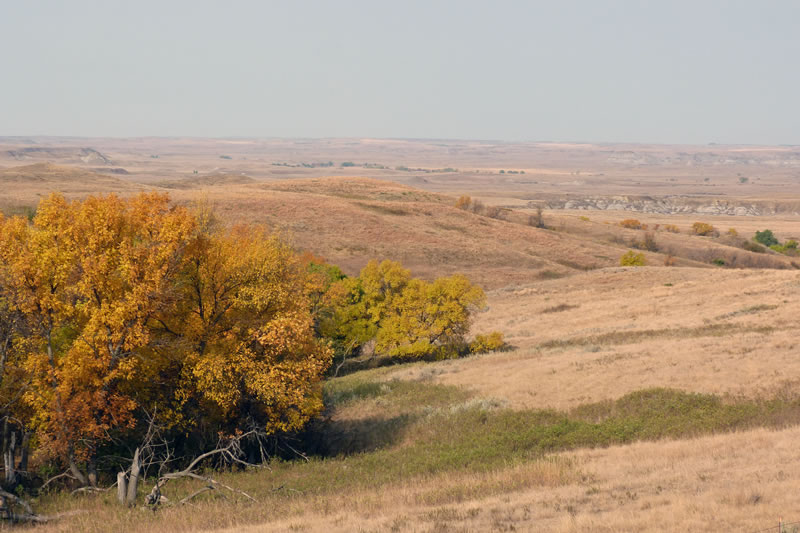Autumn Arrives on the Cedar River National Grassland
Posted by Dan Svingen, Grasslands Biologist, Dakota Prairie Grasslands
Autumn has emphatically arrived on the Northern Great Plains and the Dakota Prairie Grasslands. The prairie is transitioning from the exciting greens of summer to its fall wardrobe. The former pulsating mix of blue-green western wheatgrass (Pascopyrum smithii), the light-green big bluestem (Andropogon gerardii), and the pear-green sideoats grama (Bouteloua curtipendula) have faded away. Gone too are the exuberant purples, yellows, and whites of blooming black Samson Echinacea (Echinacea angustifolia), the Maximilian sunflower (Helianthus maximiliani), and the shortfruit evening primrose (Oenothera brachycarpa).
 Autumn color on the grasslands of the northern Great Plains is one of subtle beauty. On the Cedar National Grassland in Sioux and Grant Counties in North Dakota, the grasses are turning various shades of tans and browns punctuated by the orange-yellows of green ash trees emanating from a woody draw. Photo courtesy Dan Svingen.
Autumn color on the grasslands of the northern Great Plains is one of subtle beauty. On the Cedar National Grassland in Sioux and Grant Counties in North Dakota, the grasses are turning various shades of tans and browns punctuated by the orange-yellows of green ash trees emanating from a woody draw. Photo courtesy Dan Svingen.
The prairie is metamorphosing from its summer colors to the calming browns of the fall season. The mix is now one of copper-brown little bluestem (Schizachyrium scoparium), bleached yellow-brown needle and thread grass (Hesperostipa comata), and gold-brown prairie cordgrass (Spartina pectinata). Green remains only on the stubborn leaves of the green sage and western snowberry (Symphicarpos occidentalis). The only riots of color are from the scattered trees and shrubs huddled within protected draws. The blazing gold of green ash (Fraxinus pennsylvanica), the happy yellow of cottonwoods (Populus deltoids), and the dignified russet of chokecherry (Prunus virginiana) can be seen peaking just above the edge of favored ridgelines.
 On a crisp, sky blue autumn morning, a lone green ash tree, in its fall color splendor, stands as a sentinel in a sea of tan and brown grasses on the Cedar River National Grassland. Photo courtesy Dan Svingen.
On a crisp, sky blue autumn morning, a lone green ash tree, in its fall color splendor, stands as a sentinel in a sea of tan and brown grasses on the Cedar River National Grassland. Photo courtesy Dan Svingen.
The grassland is winding down, preparing for its upcoming rest. The cattle herds are being bunched and driven home. The grasshopper sparrows are quickly departing, just as the first of the Lapland longspurs are arriving from the Arctic north to take their place. The resident mule deer, pronghorn, sharp-tailed grouse, and white-tailed deer are assessing just where they will attempt to survive the upcoming trial that is winter. Through it all, a badger rambles along muttering to itself as it plows through the grass, seemingly oblivious to the loss of the greens, the gains of the browns, and the constancy of the wind.
 Islands of green sage punctuate a sea of grasses in their fall splendor set against a beautiful blue sky and puffy white clouds on the Cedar River National Grassland. Photo courtesy Dan Svingen.
Islands of green sage punctuate a sea of grasses in their fall splendor set against a beautiful blue sky and puffy white clouds on the Cedar River National Grassland. Photo courtesy Dan Svingen.

